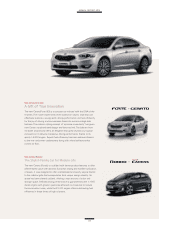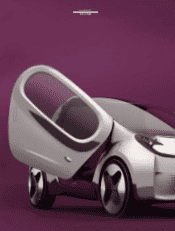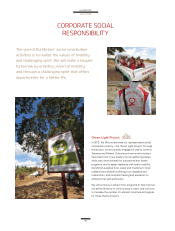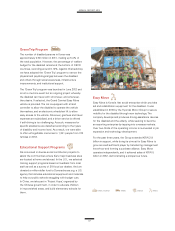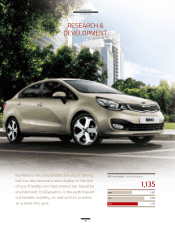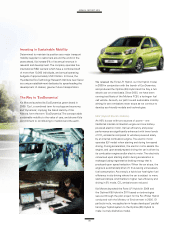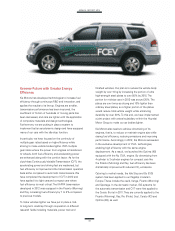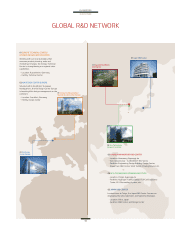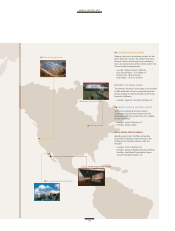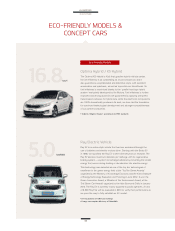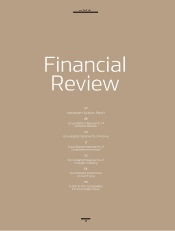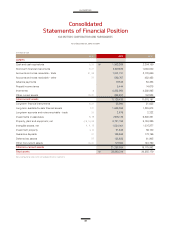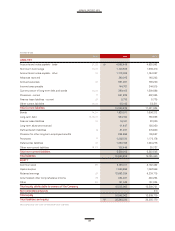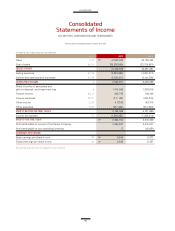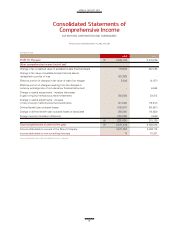Kia 2012 Annual Report Download - page 41
Download and view the complete annual report
Please find page 41 of the 2012 Kia annual report below. You can navigate through the pages in the report by either clicking on the pages listed below, or by using the keyword search tool below to find specific information within the annual report.
Greener Future with Greater Energy
Efficiency
Kia Motors has developed technologies to increase fuel
efficiency through continuous R&D and innovation, and
applies the results to its line-up. Engines are smaller,
transmission performance has been improved, the
coefficient of friction of hundreds of moving parts has
been decreased, and cars are lighter with the application
of composite materials and design technologies.
Furthermore, we are putting in place a system to
implement better aerodynamic design and have equipped
many of our cars with the idle-stop function.
In particular, we have focused on the continuity of
multiple gear ratios based on high-efficiency while
striving to make vehicle bodies lighter. With multiple
gear ratios where the power from engines is transferred
to wheels, both fuel efficiency and accelerating power
are enhanced along with the comfort factor. As for the
clutch-less Continuously Variable Transmission (CVT), the
accelerating power and driving feel are weakened, but
fuel efficiency is improved and the transmission operation
feels softer compared to automatic transmissions. We
have completed the development of CVT in 2012 and
have applied it to light cars and compact cars where
fuel efficiency is most critical. The KAPPA transmission
developed in 2012 was equipped in the Picanto (Morning)
and Ray, increasing fuel efficiency by 7 to 8% compared
to previous models.
To make vehicles lighter we have put in place a mid-
to long-term roadmap through cooperation in different
research fields including materials, power train and
finished vehicles. Our plan is to reduce the vehicle body
weight by over 10 kg by increasing the portion of ultra
high-strength steel plates to over 50% by 2015. The
portion for mid-size cars in 2012 was around 20%. The
plates are over twice as strong and 10% lighter than
ordinary steel plates, so a higher portion of the plates
would reduce total vehicle weight while enhancing
durability by over 20%. To this end, we have implemented
a joint project with a steel subsidiary within the Hyundai
Motor Group to make our car bodies lighter.
Kia Motors also seeks to achieve downsizing of its
engines, that is, to reduce or maintain engine size while
raising fuel efficiency, reducing emissions and improving
performance. Accordingly, in 2012, Kia Motors succeeded
in the exclusive development of CVVL technologies,
enabling high efficiency with the same engine
displacement. As a result, we launched the Optima (K5)
equipped with the Nu CVVL engine. By downsizing from
4-cylinder to 3-cylinder engines for compact cars like
the Picanto (Morning) and Ray, fuel efficiency has been
dramatically improved with reduced CO
2
emissions.
Catering to market needs, the Idle Stop and Go (ISG)
system has been applied to our flagship models in
Europe. These include the cee’d, Venga, Picanto (Morning)
and Sportage. In the domestic market, ISG systems for
the automatic transmission and CVT were first applied to
the Cerato (Forte) in 2011. They are currently applied to the
Picanto (Morning), Ray, Rio (Pride), Soul, Cerato (K3) and
Optima (K5), as well.




